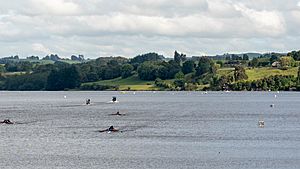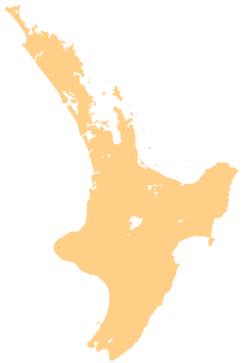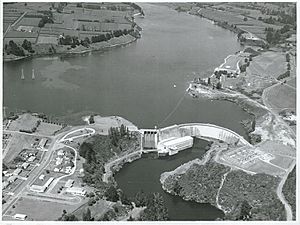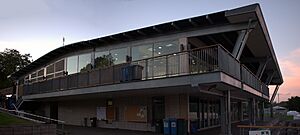Lake Karapiro facts for kids
Quick facts for kids Lake Karapiro |
|
|---|---|

Lake Karapiro
|
|
| Location | North Island |
| Coordinates | 37°55′43″S 175°32′40″E / 37.92856°S 175.544529°E |
| Lake type | reservoir |
| Primary inflows | Waikato River |
| Primary outflows | Waikato River |
| Basin countries | New Zealand |
| First flooded | April 1947 |
| Max. length | 11.0 kilometres (6.8 mi) |
| Max. width | 0.9 kilometres (0.56 mi) |
| Surface area | 7.7 km2 (3.0 sq mi) |
| Average depth | 11.0 metres (36.1 ft) |
| Max. depth | 30.5 metres (100 ft) |
| Water volume | 0.085 cubic kilometres (0.020 cu mi) |
| Surface elevation | 50.5–53.5 metres (166–176 ft) |
Lake Karapiro (Māori: Karāpiro) is an artificial lake in New Zealand's North Island. It was created in 1947 by building a dam across the Waikato River. The lake is about 8 kilometres south-east of Cambridge.
Lake Karapiro was made to store water for the Karapiro power station, which generates electricity. It is also one of New Zealand's top places for rowing. Many high-performance rowers train here.
Contents
History of Lake Karapiro
Around the year 1600, a fortified village called Te Tiki o Ihingarangi was built near where the lake is now. This village was known as a pā.
In 1830, a battle took place near the lake. The Ngāti Hauā tribe defeated the Ngāti Maru tribe. After the battle, fallen warriors were cremated on rocks by the Waikato River. This spot became known as Karāpiro. The name comes from Māori words: karā means "basaltic stone," and piro means "foul smelling." This area was later covered by the lake.
The building of the Karapiro Dam started in 1940. However, World War II caused delays because there were not enough workers or materials. The dam was finished in early 1947, four years later than planned.
When the lake was filled, it covered the old Horahora Power Station. This station stopped working on April 4, 1947, as the water level rose. By April 10, 1947, the lake was full enough for the Karapiro power station to start making electricity.
A Top Spot for Rowing
Lake Karapiro is known as one of New Zealand's best places for rowing. It has hosted major international events, including the World Rowing Championships in 1978 and 2010. It also held the rowing events for the 1950 British Empire Games.
The first national rowing championships, then called the Dominion championships, were held on the lake in 1949. Since the 1980s, Lake Karapiro and Lake Ruataniwha in the South Island take turns hosting these events. They also host the New Zealand secondary school rowing championships, known as the Maadi Cup. Many rowers who train here live in nearby Cambridge.
In 2006, a group of experts from the International Rowing Federation visited the lake. They said Lake Karapiro was one of the fairest and most beautiful rowing courses they had ever seen. The Sir Don Rowlands Centre, a special building for rowing events, was finished in June 2010.
Making Electricity
The Karapiro Power Station is next to the dam and uses water from the lake to make electricity. It is the eighth and last power station on the Waikato River. Water from the lake flows through large machines called turbines. These turbines spin generators, which create electricity.
The power station can produce 96 megawatts of electricity. This electricity is sent to the national power grid. The station is important for keeping the Waikato River flowing properly below the dam.
Unwanted Plants and Animals
Lake Karapiro has some unwanted plants and animals that are not native to New Zealand. These are called invasive species.
- Hornwort: This plant comes from North America and grows underwater. It is considered a very harmful plant in New Zealand. It can take over the lake and change the environment.
- Gold Clams: In May 2023, gold clams were found in Lake Karapiro. These clams grow and reproduce very quickly. They can harm the lake's ecosystem by eating too much of the tiny plants (phytoplankton) that other animals need. They also release a lot of nutrients and can crowd out other life on the lakebed.
Even with these invasive species, the lake is still used for fun activities. However, it's very important that people clean their boats and gear carefully. This helps stop the gold clams and hornwort from spreading to other lakes and rivers. Both hornwort and gold clams are listed as unwanted organisms under New Zealand's Biosecurity Act.
Climate Around the Lake
| Climate data for Lake Karapiro (1991–2020) | |||||||||||||
|---|---|---|---|---|---|---|---|---|---|---|---|---|---|
| Month | Jan | Feb | Mar | Apr | May | Jun | Jul | Aug | Sep | Oct | Nov | Dec | Year |
| Mean daily maximum °C (°F) | 24.4 (75.9) |
24.8 (76.6) |
23.0 (73.4) |
19.9 (67.8) |
16.9 (62.4) |
14.3 (57.7) |
13.5 (56.3) |
14.6 (58.3) |
16.0 (60.8) |
18.0 (64.4) |
20.0 (68.0) |
22.5 (72.5) |
19.0 (66.2) |
| Daily mean °C (°F) | 19.4 (66.9) |
20.0 (68.0) |
18.2 (64.8) |
15.5 (59.9) |
12.8 (55.0) |
10.4 (50.7) |
9.6 (49.3) |
10.6 (51.1) |
12.0 (53.6) |
13.8 (56.8) |
15.5 (59.9) |
18.0 (64.4) |
14.7 (58.4) |
| Mean daily minimum °C (°F) | 14.5 (58.1) |
15.1 (59.2) |
13.4 (56.1) |
11.0 (51.8) |
8.8 (47.8) |
6.6 (43.9) |
5.7 (42.3) |
6.5 (43.7) |
8.0 (46.4) |
9.6 (49.3) |
11.0 (51.8) |
13.6 (56.5) |
10.3 (50.6) |
| Average rainfall mm (inches) | 77.4 (3.05) |
66.2 (2.61) |
66.6 (2.62) |
97.5 (3.84) |
100.4 (3.95) |
113.5 (4.47) |
124.0 (4.88) |
113.9 (4.48) |
99.5 (3.92) |
85.1 (3.35) |
79.2 (3.12) |
95.2 (3.75) |
1,118.5 (44.04) |
| Source: NIWA | |||||||||||||
Images for kids





